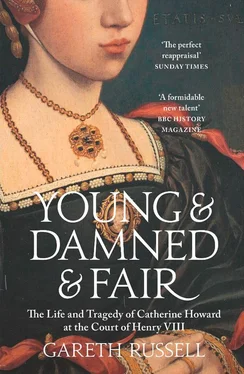The veil between life and death was made permeable by the teachings of Christianity. Everywhere one looked, there was proof of society’s lively fascination with the next life. Death was the great moral battleground between one’s strengths and weaknesses; the supreme test came when the finite perished and the eternal began. To die well, in a spirit of resignation to the Will of God and without committing a sin against hope by despairing of what was to come next, was a goal endlessly stressed to the Faithful in art, sermons, homilies and manuals. Within the great basilica of Saint-Denis in Paris, the tomb of King Louis XII and Anne of Brittany, his queen, showed the couple rendered perfect in the stonemasons’ marble, united atop the monument, their bejewelled hands clasped in prayer, their robes and crowns exquisitely carved; but beneath that sculpture the craftsmen had offered a very different portrait of the royal forms – there, the bodies of the king and queen were shown twisting and writhing in the first stages of putrefaction, their feet bare, their hair uncovered and their flesh pullulating with the onset of corruption.7 Throughout Europe, these cadaver tombs, the transi , were commissioned by the rich and the powerful to show their submission to the final destruction of their flesh and with it the removal of this sinful world’s most potent temptations. In corruption they had been born and so through corruption they could be born again.
In the sixteenth century, life was precious, truncated at any moment by plague, war or one of a thousand ailments that would be rendered treatable in the centuries to come, and so the people embraced it with a rare zeal. But living well, as Anne Boleyn had noted at her trial, also meant dying well.8 Christians were supposed to die bravely because of the surety of mercy that even the weakest and most sinful was guaranteed by their religion, provided he or she had respected its doctrines and honoured its God. Before they were marched to the hill, Cromwell told Lord Hungerford that ‘though the breakfast which we are going to be sharp, yet, trusting to the mercy of the Lord, we shall have a joyful dinner’.9 To the overwhelming number of Henry VIII’s subjects, Christianity was not a theory, it was not a belief system, it was not one religion among many – it was, more or less, a series of facts, the interpretation of which could be debated, but whose essential truth was inescapable and uncontested. The result of this way of accepting and experiencing their faith was that sixteenth-century Christians often behaved in ways which were paradoxically far more devout but also far more relaxed than their modern-day co-religionists. The line between sinners and the flock was not so clearly delineated, because even the worst members of society were still, in one way or the other, almost certainly believing Christians. All men were weak, all men would fail, all men would die, all men could be saved.
A celebrated person’s execution, their final public performance, was such an exciting event that people made the journey into London especially for it. Vast crowds surged through London, converging on Tower Hill to watch the annihilation of the detested commoner who had somehow risen to become Earl of Essex – a sign of royal favour given to him only a few weeks before he was arrested at a meeting of the Privy Council and taken to the Tower. The last ascent in the life of the Englishman who had risen farther than anyone else in his century were the wooden steps to the scaffold. Thomas Cromwell had not been a popular figure, but royal advisers seldom are. Snobbery played a large role in his reputation – an English diplomat described Cromwell as a man who had been ‘advanced from the dunghill to great honour’ – but so did his actions.10 Ruthless, determined, brilliant, and utterly Machiavellian, Cromwell had overseen the destruction of many an aristocratic career and the evisceration of the old religion in England. Many of his opponents blamed him for tearing asunder the spiritual framework that they had lived, and hoped to die, by. The sacraments and liturgies of the Church had given a rhythm to the year, they had bestowed the tools for salvation on the faithful for centuries, and marked every major moment in a Christian’s life. In 1536, Cromwell had weathered the Pilgrimage of Grace, a traditionalist uprising which spread through most of northern England and which had demanded his removal from power. However, he could not survive the loss of the king’s favour four years later. His enemies surrounded him and he was condemned to death on a long list of crimes that included heresy, treason, and financial corruption.
The crowds entering the capital on 28 July 1540 came from every background, with well-born women wearing veils to shield their faces from the sun, while urchins wore battered hand-me-down cheap leather shoes which prevented their feet from being cut on the animal bones and refuse that littered the city streets. With no rain, the mud in the streets had become a dry dust that would turn into ankle-depth filth when the clouds broke in autumn. The spectators passed through the capital’s eighteen-foot high defensive walls via one of the seven gates. Those travelling in from the Hampshire and Surrey countryside entered through Newgate, while those from nearby Smithfield, home to a bustling meat market, accessed the City at Aldersgate. Smithfield also contained London’s designated red-light district, the aptly named Cock Lane. Subtlety in the assigning of place names was not a medieval strongpoint. The southwestern city of Exeter had renamed one of its rivers Shitbrook, because of the amount of faeces and waste it contained, and in Oxford, students hoping for an early sexual experience courtesy of the town’s prostitutes could find it on Gropecunt Lane, a narrow alley that ran from just opposite the university church of St Mary the Virgin down to the entrance of Oriel College.11
Rather more elegant sights awaited those who were travelling towards Cromwell’s execution via the Strand, a long straight road lined with the episcopal palaces and impressive homes of the aristocracy. The Strand had been the site of the Savoy Palace, principal residence of Richard II’s powerful uncle John of Gaunt, until it was burned down during the Peasants’ Revolt of 1381. It was eventually replaced by the Hospital of St John the Baptist, one of the most impressive medical establishments in early modern Europe, founded under the patronage of Henry VIII’s father. Near the hospital was one of the Eleanor Crosses, funerary monuments erected by a grief-stricken Edward I in 1290 to mark each of the fourteen spots where his wife’s coffin rested on its final journey to Westminster Abbey. This, the last halt before the interment, was now where professional water-sellers took advantage of the area’s excellent plumbing, which on occasion pumped the local fountains with wine or beer to celebrate an especially significant royal event – the last time had been for the birth of the heir to the throne, Prince Edward, in 1537. On a hot and busy day like this, as families and groups of friends swarmed towards the Tower, the Charing Cross water-sellers could reasonably have expected to turn a handsome profit.12
London in July 1540 was the perfect capital for Henry VIII’s domains: a broken society whose fracture lines were both reflected and grotesquely magnified throughout the city. Along the banks of the Thames, formerly semi-rural areas like Deptford and Woolwich were now shipyards for the Royal Navy, where titanic amounts of money poured into the construction of warships designed to repel the French and Spanish, if they ever came. Londoners grumbled at the despoiling of some of the few green areas left to them; they valued their leaf-dappled refuges so much that earlier in the king’s reign thousands had rioted over plans to encroach on the area of parkland around Soho, a district which got its name from a traditional hunting cry, ‘So, ho!’
Читать дальше











![John Bruce - The Lettsomian Lectures on Diseases and Disorders of the Heart and Arteries in Middle and Advanced Life [1900-1901]](/books/749387/john-bruce-the-lettsomian-lectures-on-diseases-and-disorders-of-the-heart-and-arteries-in-middle-and-advanced-life-1900-1901-thumb.webp)
